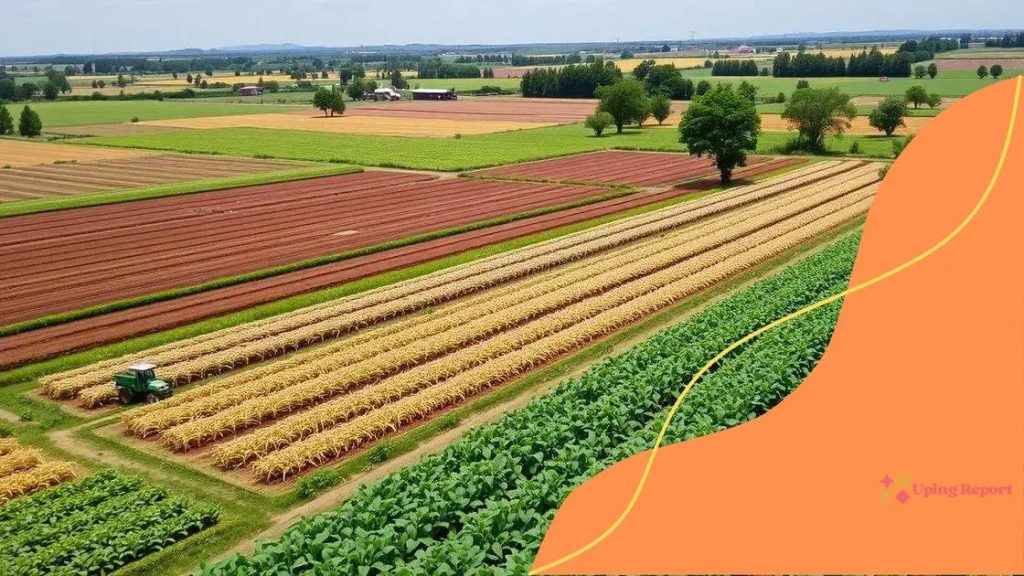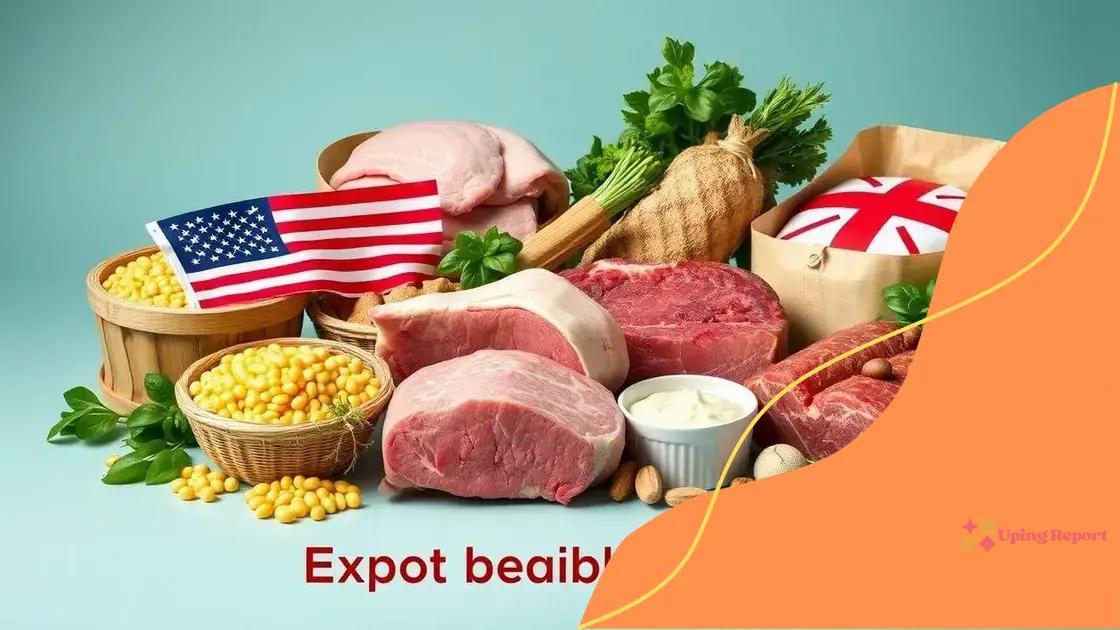U.S. boosts farm exports to U.K. amid rising demand

The U.S. boosts farm exports to the U.K. by focusing on high-demand products like beef, soybeans, and pork, while adapting to consumer preferences and overcoming challenges like competition and regulatory barriers.
U.S. boosts farm exports to U.K. shows how agricultural exchanges are evolving in response to global demand. Have you ever wondered how these changes impact farmers on both sides of the Atlantic?
Current trends in U.S. farm exports
The current trends in U.S. farm exports showcase a dynamic landscape shaped by various factors including consumer demand and trade agreements. With the U.K. emerging as a major market, the opportunities for U.S. farmers are expanding.
Growing Demand for U.S. Products
American agricultural products are recognized globally for their quality. As a result, many countries, particularly in Europe, are increasing their purchases. The U.K. market, in particular, has seen a surge in demand for products like beef, soybeans, and dairy. These products often offer more competitive pricing compared to local alternatives.
- Beef exports to the U.K. have risen significantly, driven by consumer preference for premium quality.
- U.S. soybeans remain a staple for the expanding livestock feed sector in the U.K.
- Dairy products, including cheese and milk, are highly sought after by British consumers.
In addition to meeting consumer preferences, U.S. farmers are also adapting to regulatory changes that facilitate easier access to international markets. Recent shifts in policies have helped streamline the export process, making it more efficient for farmers to ship their products abroad.
Technological Advancements
With the advancement of technology in agriculture, farmers are now equipped to enhance their production efficiently. Tools such as precision farming help in optimizing yield, which is essential for exporting high-quality products. This technological edge gives U.S. farmers a competitive advantage in the U.K. market.
The use of data analytics allows farmers to anticipate market needs better and align their production accordingly. By leveraging these insights, they can focus on crops and products that are most likely to succeed in the U.K.
As these trends evolve, it’s crucial for farmers to stay informed about both market demands and agricultural practices. This ongoing awareness will enable them to maximize their returns and maintain a strong presence in international trade.
In summary, the current trends in U.S. farm exports reflect a growing market driven by consumer preferences, regulatory support, and technological advancements. U.S. farmers are well-positioned to meet these demands and seize new opportunities offered by international trade.
The impact of U.K. demand on U.S. agriculture
The impact of U.K. demand on U.S. agriculture is significant and transformative. As British consumers seek high-quality products, U.S. farmers are poised to benefit from this growing market.
Price Increase for Key Exports
Increased demand from the U.K. often leads to a rise in prices for key exports such as wheat, corn, and fruits. These price changes can boost the income farmers receive, allowing them to invest more in their operations.
- Wheat exports have shown a notable increase, especially given the U.K.’s reliance on imports.
- Corn is increasingly being used in U.K. products, expanding its market reach.
- Fruits like apples and pears from the U.S. are popular choices among British consumers.
As U.K. demand grows, farmers are adjusting their production strategies to focus on crops that align with market preferences. This responsiveness helps maximize their profitability while ensuring that U.S. agriculture meets international standards.
Supply Chain Innovation
The growth in demand also encourages innovation within the supply chain. U.S. farmers are finding new ways to distribute their products more efficiently. With the need for timely delivery to maintain freshness, logistics are evolving rapidly.
Farmers are adopting technologies like smart farming to improve yield and streamline processes. These advancements allow them to track their produce from farm to market effectively. By investing in technology, growers are enhancing their competitive edge.
In battle with rising global competition, understanding the specific needs of the U.K. market has led many U.S. farmers to refine their approaches. This understanding can include everything from crop selection to packaging and marketing strategies.
The interconnectedness of U.S. and U.K. agricultural markets demonstrates a vital relationship that benefits both. As the U.K. leans on U.S. agriculture for quality, U.S. farmers are not only meeting demand but thriving in an evolving global marketplace.
Key products exported from the U.S. to the U.K.

The key products exported from the U.S. to the U.K. play a vital role in strengthening agricultural ties between these two nations. As American farmers adapt to meet the demands of the U.K. market, several specific products stand out.
Top Agricultural Exports
Among the most common exports, soybeans, pork, and beef take center stage. These products not only fulfill the needs of British consumers but also contribute significantly to the U.S. economy.
- **Soybeans** are essential for animal feed and cooking oils, making them a staple in U.K. agriculture.
- **Pork** from U.S. farms is highly regarded for its quality and flavor, catering to diverse culinary preferences.
- **Beef**, especially premium cuts, is sought after for its richness and is a favorite in many U.K. households.
The demand for these products is driven by changing consumer habits and the growing interest in healthy eating. As British consumers become more aware of nutritional benefits, they turn to U.S. imports for high-quality options.
Other Notable Exports
In addition to these main exports, the U.S. also supplies corn, dairy products, and various fruits and vegetables. Each of these items complements the British diet and enhances the variety available to consumers.
American corn, for instance, is widely used in processed foods and livestock feed. Dairy products like cheese from the U.S. enjoy popularity due to their diverse flavors and high quality. Fresh fruits, such as apples and berries, are especially appealing to those looking for healthy snack options.
As these trade relationships continue to evolve, U.S. farmers remain responsive to U.K. market trends, ensuring that they provide the types of products consumers desire. This proactive approach not only benefits farmers but also helps maintain a robust agricultural export economy.
Challenges facing U.S. farmers in the export market
The challenges facing U.S. farmers in the export market are complex and multifaceted. As global demand increases, farmers encounter various obstacles that can impact their ability to compete effectively.
Market Competition
One significant challenge is strong competition from other nations. Countries like Brazil and Argentina are major agricultural producers, particularly in soy and beef. These competitors often have lower production costs, which can influence pricing in international markets.
- **Cost of production**: Farmers need to balance high production costs with competitive pricing to stay relevant.
- **Quality competition**: Competing with lower-cost, high-quality products can be tough for U.S. farmers.
- **Shifts in demand**: Changes in consumer preferences may push buyers towards other suppliers.
It’s crucial for U.S. farmers to maintain high standards, as quality remains a significant factor for international buyers. Enhancing quality while managing costs often requires innovation.
Regulatory Barriers
Regulatory issues further complicate the export landscape. Each country has different food safety standards and import regulations.
Navigating these regulations can be challenging. U.S. farmers must ensure compliance with both domestic and international laws, which can often be time-consuming and costly. For example, specific certifications may be necessary for products like organic produce or meat.
Additionally, tariffs and trade agreements can impact export profitability. Changes in trade policies can result in sudden shifts in tariffs, making it difficult for farmers to predict market conditions.
Logistics is another element where challenges arise. Shipping costs and delays in transportation can affect the timely delivery of products. Farmers are constantly seeking efficient ways to manage supply chains to ensure that their goods reach international markets in optimal condition.
Despite these hurdles, U.S. farmers continue to adapt and find solutions. By embracing technology and sustainable practices, they can enhance their resilience in the global market.
Future outlook for U.S.-U.K. agricultural trade
The future outlook for U.S.-U.K. agricultural trade is promising, as both nations continue to strengthen their trading relationship. As agricultural practices evolve and consumer preferences shift, U.S. farmers are well-positioned to meet the demands of the U.K. market.
Increasing Demand for Sustainable Practices
One significant trend shaping the future of agricultural trade is the growing emphasis on sustainability. U.K. consumers are increasingly looking for sustainable and ethically produced food. This trend encourages U.S. farmers to adopt more environmentally friendly practices.
- Organic farming methods are becoming more popular, leading to higher quality and demand.
- Reducing carbon footprints is a focus, making products more appealing to eco-conscious consumers.
- Transparency in production methods builds trust and attracts U.K. buyers.
Farmers who prioritize these practices may find expanding markets in the U.K., where consumers are willing to pay a premium for sustainably sourced products.
Innovation and Technology
Technological advancements are also expected to play a role in the future of U.S.-U.K. agricultural trade. Innovations such as precision agriculture, smart logistics, and data analytics are already transforming farming.
Farmers can now use technology to:
- Track crop health and optimize yields with better data.
- Streamline supply chains to reduce waste and improve delivery times.
- Enhance the quality of products through controlled farming environments.
These technological improvements not only boost productivity but also create opportunities for U.S. farmers to export premium products to the U.K.
As trade agreements continue to evolve, the potential for increasing agricultural exports remains strong. Political relationships, changing regulations, and consumer preferences in the U.K. will likely influence these dynamics. By aligning with market needs and emphasizing sustainability and innovation, U.S. farmers can secure a bright future in the global agricultural market.
FAQ – Frequently Asked Questions about U.S.-U.K. Agricultural Trade
What are the key agricultural products exported from the U.S. to the U.K.?
Key products include soybeans, beef, pork, and various fruits and vegetables that cater to the growing demand in the U.K.
How are U.S. farmers adapting to the demands of U.K. consumers?
U.S. farmers are focusing on sustainable practices and technology to meet the increasing demand for high-quality, ethically produced food.
What challenges do U.S. farmers face in the export market?
Farmers face challenges such as competition from other countries, regulatory barriers, and the need to navigate complex logistics.
What does the future look like for U.S.-U.K. agricultural trade?
The future is promising with increasing demand for sustainable products, technological advancements, and strong potential for growth in exports.
